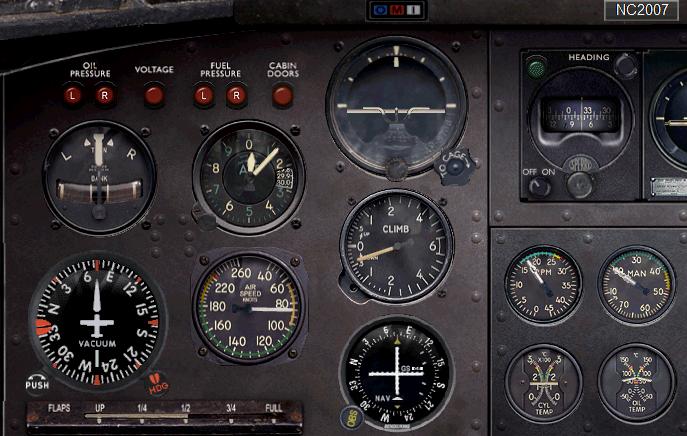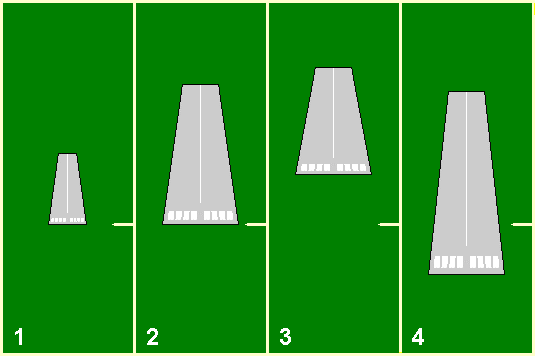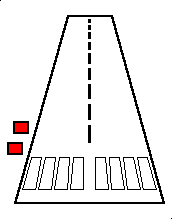
While every flight segment is important, the approach is the most
crucial. A good landing can only follow a satisfactory approach, and the
converse is true.
Information in this section pertains to VFR flights only.
Here's where the flight gets busy. A straight-in approach has been approved,
so set up for the initial approach at 3000 feet AGL. Slow the aircraft from
its normal descent speed to a manageable 105 kts. Drop one notch of
flaps—139 kts max., leave the gear up, pull the throttles back to 17 in.
M.P., and the props back to 1700 RPM.
Retrim as necessary to keep the rate of descent at 500 fpm or less at about
105 kts IAS.
About five miles from the airport transition to the final approach
configuration.

Transition from Initial Approach to Final Approach configuration at the
Outer Marker, about 5 NM from the runway threshhold. Bring the speed back to
85 kts, lower the gear, and drop to half flaps—99 kts max. Push the props to
high RPM. As you near the field, you can drop full flaps, and decrease the
airspeed to 80 kts.
Be alert; with everything down and dirty you will need to increase the power
and raise the trim to maintain your desired rate of descent. Don't let the
sink rate become excessive and mess up your approach.
The props are in the high RPM so that you need only shove the throttle
forward if a go around becomes necessary.
Hold 80 kts on final approach, with full flaps. If there are strong
gusts, add half the gust speed to your final-approach speed. For example, if
the wind is 12 kts, gusting to 20, the gusts are 8 kts. Add half of that, or
4 kts to your final approach speed of 80 kts, which gives you 84 kts on
final. Diligently maintain the exact final approach speed. Don't add an
extra knot for each of your children and grandchildren.
If the approach isn't "just right," a sloppy landing will follow. The
importance of a good approach can't be overstated.
Laterally lining up with a runway is fairly easy. It's less obvious,
though, to ascertain whether your established rate of descent will lead you
to the runway, send you too far, or drop you too short.
The pilot has two aids to help in this task. The first is visual cues. The
aiming-point technique will improve all of your landings.
Begin by focusing your attention on the threshold end of the runway. That
will be your aiming point. The object is to adjust your rate of descent so
that the aiming point does not move during your entire approach to land. The
aiming point should only grow larger in size as you get closer.
A china marker pencil will help you learn this technique until you have a
few landings under your belt using this method.
After you begin your descent to the runway and everything is fairly stable,
pause your Flight Simulator and mark a line on the monitor beside the
approach end of the runway, to emphasize your aiming point. Then continue
your approach. The end of the runway must not stray from the line you drew
on the screen.
If you have set your rate of descent precisely correct, it will be as if
you're suspended in air; there will be no movement of the runway as you
approach. It will almost be eerie. Any movement of the approach end of the
runway signifies that the point of your actual landing will differ from your
point of intended landing. Here are the possibilities:

Once you alert your senses to discern any movement of the runway
threshold, this becomes a very natural technique to use when landing.
Remember, again. Adjust rate of descent with power, the throttle, not by
changing the position of the yoke.
The second aid to help pilot's set the correct rate of descent is the
VASI system, or Visual Approach Slope Indicator.
VASIs come in several varieties, but a typical system includes two sets of
light bars placed on the left side of the runway, one nearer the landing
threshold than the other. Lenses split the light into red and white beams.
Three combinations of lights exist with this arrangement. If you're
approaching the runway on the proper glide path, usually a three-degree
slope, you'll see a red light above a white light.



Intuitively, of course, one understands that red-red is "danger," or low, and then the others become obvious.
A three-degree glide path for landing is considered optimum. Most VASI
and ILS systems are designed with that glide path.
The rule of thumb for the proper rate of descent to maintain a standard 3°
glide path is five times the aircraft's ground speed. With an 85 kt approach
speed, no wind, the rate of descent should then be 5 × 85, or about 425 fpm.
If you're battling a 20 kt headwind, ground speed reduces to 65 kts, and the
needed rate of descent for a 3° glide path lessens to 325 fpm.
These are approximate numbers and are on the low side, but this rule of
thumb gets you established close enough so that only minor power adjustments
will be necessary to maintain the optimum three-degree glide path.
The mathematically correct rate of descent for a DC-3 approaching at 85 kts
is 451 fpm (no wind) to stay on a 3° glide slope. So the rule of thumb keeps
you slightly above the glide path, the good side to be on if not centered.